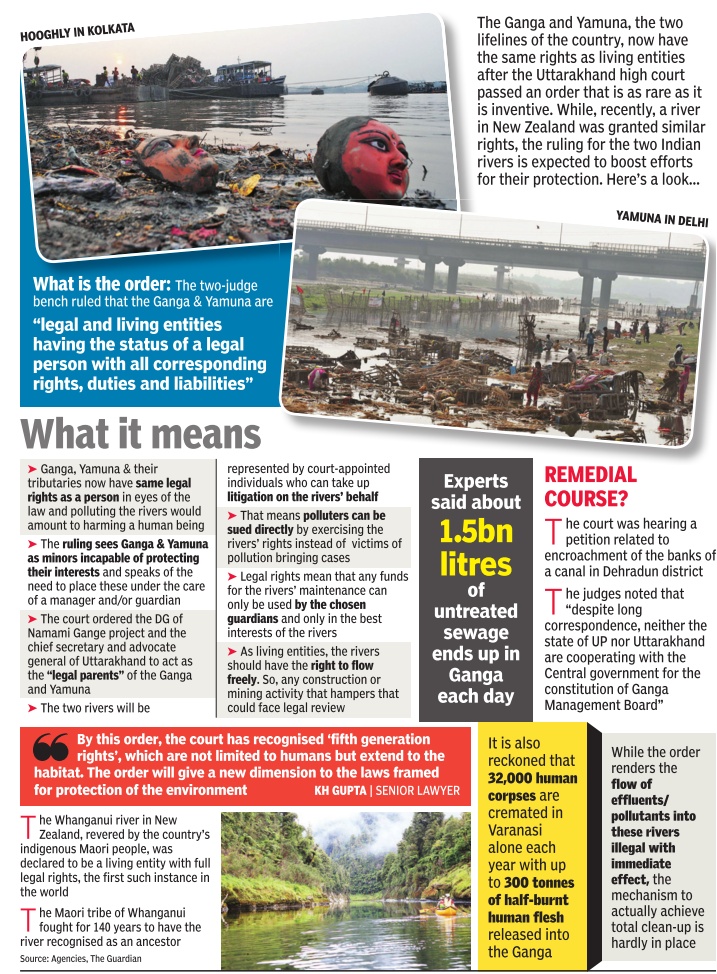Ganga, Yamuna: legal rights
This is a collection of articles archived for the excellence of their content. |

The Ganga and Yamuna, the two lifelines of the country, now have the same rights as living entities after the Uttarakhand high court passed an order that is as rare as it is inventive. While, recently, a river in New Zealand was granted similar rights, the ruling for the two Indian rivers is expected to boost efforts for their protection. Here's a look...
The Times of India
Contents |
Legal rights of rivers
Ganga, Yamuna, tributaries: legal, living entities
Namami Gange Head Made Their Representative
In the first order of its kind in the country , the Uttarakhand high court on Monday decreed that the the Ganga and the Yamuna as well as their tributaries and sister bodies be declared “legal and living entities having the status of a legal person with all corresponding rights, duties and liabilities“.
This, the court said, was to ensure “preservation and conservation of the two rivers and to protect the recognition and faith of society“.
A division bench of Justices Alok Singh and Rajiv Sharma noted that “the extraordinary situation has arisen since the rivers Ganga and the Yamuna are losing their very existence“.
The court's order comes days after a landmark bill passed in New Zealand making the Whanganui river, revered by the indigenous Maori people, the first in the world to be recognised as a living entity with full legal rights.
The status accorded to the Ganga and the Yamuna, legal experts said, would mean that if anyone was found polluting the rivers, it would amount to harming a human being. “By this order, the court has recognised `fifth generation rights' which are not limited to humans but extend to the habitat. The order will give a new dimension to the laws framed for protection of the environment,“ said senior lawyer K H Gupta. The court named the director of Namami Gange, the chief secretary of Uttarakhand and the advocate general of the state “persons in loco parentsi“ -the human face representing the rivers.
“All the Hindus have deep `astha' in the Ganga and the Yamuna and they collectively connect with these rivers.The rivers are central to the existence of half of the Indian population and their health and well being. They have provided both physical and spiritual sustenance to all of us from time immemorial,“ the judges said.
The judges noted that a “startling revelation“ had been made by the senior joint commissioner, ministry of water resource & Ganga rejuvenation, that “despite long correspondence, neither the state of UP nor the state of Uttarakhand are cooperating with the central government for the constitution of Ganga Management Board“.
The HC ordered the central government to constitute the board and make it functional “within a period of three months... We need not remind the state governments that they are bound to obey the orders passed by the central government, failing which consequences may ensue under Article 365 of the Constitution of India“.
Uttarakhand: Ganga's status as living entity untenable
The Uttarakhand government is set to approach the Supreme Court to “put forth its view“ on the state high court's decision to grant living status to Ganga and Yamuna, citing “technical, geographical and administrative issues“ with implementation of the order as the river flows through five states.
Uttarakhand minister and spokesperson of the state government Madan Kaushik told TOI that the Uttarakhand government has written a letter to the Centre to seek its permission to approach the Supreme Court.Kaushik said Uttarakhand was asking Centre's permission since the latter has filed a special leave petition in this regard. In a landmark judgment on March 20 this year, the Uttarakhand high court accorded the status of “living human entities“ to Ganga and Yamuna, two of India's most sacred rivers. Talking to TOI, Kaushik said, “Let me be very clear that we are not against according of living entity status to the two holy rivers Ganga and Yamuna. But while according the legal status of living humans to Ganga and Yamuna, the high court has named chief secretary of Uttarakhand, Namami Gange director and advocate general of the state the legal parents of the two rivers. How can the chief secretary here be held accountable if the river is polluted in West Bengal, Bihar, Jharkhand or UP?“ Kaushik added, “We just want an opportunity to put forth our views in SC.“
Gangotri, Yamunotri, too, are `living entities'
Vineet Upadhyay, Gangotri & Yamunotri too `living entities', April 1, 2017: The Times of India
Ten days after it declared the rivers Ganga and Yamuna as “living entities“, Uttarakhand high court declared on Friday the glaciers from where the two rivers originate, Gangotri and Yamunotri respectively , as legal entities as well.
The order delivered by Justices Rajiv Sharma and Alok Singh said that the glaciers will have “the status of a legal person, with all corresponding rights, duties and liabilities of a living person“. This, the HC said, was being done “to preserve and conserve them“.
The court also declared several persons, including the state chief secretary , advocate general, director of Namami Gange, as well as senior advocate MC Mehta “the persons in loco parentis as the human face to protect, conserve and preserve the glaciers.“